Case Studies
Creating and optimizing cash plans
Maintaining an optimal cash balance is crucial for a sound financial plan, as excessive cash can hinder returns, while insufficient cash may lead to liquidity issues, often leading to the use of credit and debt. Achieving the right balance is critical to a robust financial plan and peace of mind.
Three Tiers of Cash
Cash can be divided into three unique tiers with various benefits and drawbacks.
Tier 1
Checking Account
- Most liquid, easily accessible to pay for monthly bill.
- Often serves as a slush fund for incoming paychecks and outgoing cash needs.
Tier 2
Checking Account, High Yield Savings Account, Money Market
- Maintains liquidity with higher rates of returns than a checking account while still being relatively accessible to pay upcoming expenses.
- Provides an emergency fund that can be accessed quickly for unexpected bills.
Tier 3
Cash Investing/Equivalents (Ex. Treasury Bills)
- Least liquid of the three tiers while increasing rates of returns beyond savings accounts.
- Often suitable for identifiable cash needs such as upcoming vacations or tuition payments, can also be used for emergencies.
Liquidity: how quickly you can get your hands on your cash.
Funds not required to meet liquidity needs or upcoming expenses should be allocated towards long-term goals, such as retirement or investing for children’s education expenses
Client Case Study
Determining optimal uses of cash.
The unpredictable ebb and flow of cash throughout the year can complicate life for many. For John and Samantha, navigating their cash flow was a challenge. Their employers provide a significant yearly bonus, and their children incur various one-time expenses. Building and implementing a sustainable cash plan is among the many services Heritage delivers to its clients. Gone are the days of keeping excessive cash in unproductive checking accounts, scrambling to cover future expenses, or the uncertainty of whether to invest.
Heritageassisted John and Samantha in devising a cash plan, deciding to target the $45,000 on hand. Keeping cash liquid ensures peace of mind, allowing quickaccess to funds in unforeseen situations such as job loss or marketfluctuations. Additionally, having specific targets helps them strategicallyhandle upcoming expenses, such as their son’s $40,000 college tuition bill,while working towards saving for early retirement.
With an understanding of their goals, future expenses, and cash flow, John and Samantha know what to do when their bonus arrives or when a considerable expense appears, removing uncertainty and complexity. Any money accumulated beyond this can be invested into their portfolio and help them further accomplish their retirement goal.


Funds not required to meet liquidity needs or upcoming expenses should be allocated towards long-term goals, such as retirement or investing for children’s education expenses